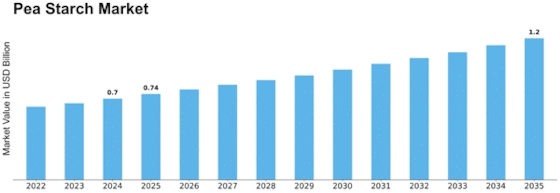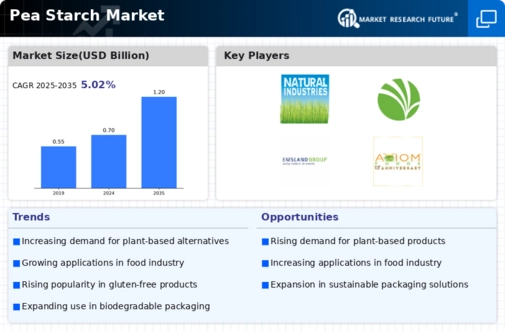Pea Starch Size
Pea Starch Market Growth Projections and Opportunities
The pea starch market is influenced by a variety of factors that collectively shape its trajectory. One of the primary drivers of this market is the increasing demand for plant-based and clean-label ingredients. As consumers become more health-conscious and seek alternatives to traditional starches, pea starch has emerged as a viable option. Its natural and non-GMO attributes align with the growing preference for clean and transparent labels in food products. This trend has prompted food manufacturers to incorporate pea starch into various applications, including baked goods, snacks, and soups, thereby driving the growth of the pea starch market. Additionally, the rise of gluten-free products has contributed significantly to the demand for pea starch. As awareness of gluten intolerance and celiac disease grows, consumers are actively seeking gluten-free alternatives in their diets. Pea starch, being gluten-free and versatile in its applications, has found a niche in the gluten-free product market. This demand is expected to continue driving the growth of the pea starch market, as more consumers adopt gluten-free lifestyles and seek products that cater to their dietary needs. Economic factors also play a role in shaping the pea starch market. The cost-effectiveness of pea starch compared to other specialty starches can influence its adoption by food manufacturers. Economic fluctuations may impact production costs, affecting pricing strategies within the market. However, the overall trend toward sustainable and plant-based ingredients has created a favorable environment for pea starch, as it aligns with both consumer preferences and industry sustainability goals. Government regulations and policies related to food ingredients also impact the pea starch market. Regulatory approvals for pea starch as a food ingredient contribute to its acceptance and use in various applications. Moreover, government initiatives promoting sustainable agriculture and plant-based alternatives can further boost the pea starch market, creating a conducive regulatory environment for its production and use. Technological advancements in food processing and ingredient extraction play a significant role in the pea starch market. Improved processing methods have allowed for the extraction of high-quality pea starch, making it more appealing to food manufacturers. Additionally, innovations in plant breeding and cultivation practices have enhanced the yield and functionality of peas as a starch source. These technological advancements contribute to the overall growth and acceptance of pea starch in the food industry. Consumer awareness and preferences are vital factors influencing the pea starch market. The rise of vegetarianism and flexitarianism has led consumers to seek plant-based alternatives across various food categories. Pea starch, being plant-derived and sustainable, resonates with these consumer preferences. Moreover, as consumers become more conscious of the environmental impact of their food choices, the eco-friendly nature of pea starch further contributes to its market appeal.


















Leave a Comment